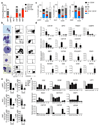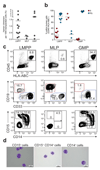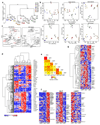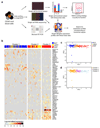Single-cell analysis reveals the continuum of human lympho-myeloid progenitor cells
- PMID: 29167569
- PMCID: PMC5884424
- DOI: 10.1038/s41590-017-0001-2
Single-cell analysis reveals the continuum of human lympho-myeloid progenitor cells
Abstract
The hierarchy of human hemopoietic progenitor cells that produce lymphoid and granulocytic-monocytic (myeloid) lineages is unclear. Multiple progenitor populations produce lymphoid and myeloid cells, but they remain incompletely characterized. Here we demonstrated that lympho-myeloid progenitor populations in cord blood - lymphoid-primed multi-potential progenitors (LMPPs), granulocyte-macrophage progenitors (GMPs) and multi-lymphoid progenitors (MLPs) - were functionally and transcriptionally distinct and heterogeneous at the clonal level, with progenitors of many different functional potentials present. Although most progenitors had the potential to develop into only one mature cell type ('uni-lineage potential'), bi- and rarer multi-lineage progenitors were present among LMPPs, GMPs and MLPs. Those findings, coupled with single-cell expression analyses, suggest that a continuum of progenitors execute lymphoid and myeloid differentiation, rather than only uni-lineage progenitors' being present downstream of stem cells.
Conflict of interest statement
Nil
Figures







Similar articles
-
A new lymphoid-primed progenitor marked by Dach1 downregulation identified with single cell multi-omics.Nat Immunol. 2020 Dec;21(12):1574-1584. doi: 10.1038/s41590-020-0799-x. Epub 2020 Oct 19. Nat Immunol. 2020. PMID: 33077975
-
Ontogenic shifts in cellular fate are linked to proteotype changes in lineage-biased hematopoietic progenitor cells.Cell Rep. 2021 Mar 23;34(12):108894. doi: 10.1016/j.celrep.2021.108894. Cell Rep. 2021. PMID: 33761361
-
Pbx1 restrains myeloid maturation while preserving lymphoid potential in hematopoietic progenitors.J Cell Sci. 2013 Jul 15;126(Pt 14):3181-91. doi: 10.1242/jcs.125435. Epub 2013 May 9. J Cell Sci. 2013. PMID: 23660001 Free PMC article.
-
Lymphoid and myeloid lineage commitment in multipotent hematopoietic progenitors.Immunol Rev. 2010 Nov;238(1):37-46. doi: 10.1111/j.1600-065X.2010.00963.x. Immunol Rev. 2010. PMID: 20969583 Free PMC article. Review.
-
Biological and molecular evidence for existence of lymphoid-primed multipotent progenitors.Ann N Y Acad Sci. 2007 Jun;1106:89-94. doi: 10.1196/annals.1392.023. Epub 2007 Apr 18. Ann N Y Acad Sci. 2007. PMID: 17442777 Review.
Cited by
-
Genome-wide transcription factor-binding maps reveal cell-specific changes in the regulatory architecture of human HSPCs.Blood. 2023 Oct 26;142(17):1448-1462. doi: 10.1182/blood.2023021120. Blood. 2023. PMID: 37595278 Free PMC article.
-
Decoding lymphomyeloid divergence and immune hyporesponsiveness in G-CSF-primed human bone marrow by single-cell RNA-seq.Cell Discov. 2022 Jun 22;8(1):59. doi: 10.1038/s41421-022-00417-y. Cell Discov. 2022. PMID: 35732626 Free PMC article.
-
Plasmacytoid dendritic cell biology and its role in immune-mediated diseases.Clin Transl Immunology. 2020 May 26;9(5):e1139. doi: 10.1002/cti2.1139. eCollection 2020 May. Clin Transl Immunology. 2020. PMID: 32489664 Free PMC article. Review.
-
Early precursors and molecular determinants of tissue-resident memory CD8+ T lymphocytes revealed by single-cell RNA sequencing.Sci Immunol. 2020 May 15;5(47):eaaz6894. doi: 10.1126/sciimmunol.aaz6894. Sci Immunol. 2020. PMID: 32414833 Free PMC article.
-
In vivo dynamics of human hematopoietic stem cells: novel concepts and future directions.Blood Adv. 2019 Jun 25;3(12):1916-1924. doi: 10.1182/bloodadvances.2019000039. Blood Adv. 2019. PMID: 31239246 Free PMC article. Review.
References
-
- Dykstra B, et al. Long-term propagation of distinct hematopoietic differentiation programs in vivo. Cell Stem Cell. 2007;1:218–229. - PubMed
-
- Benz C, et al. Hematopoietic stem cell subtypes expand differentially during development and display distinct lymphopoietic programs. Cell Stem Cell. 2012;10:273–283. - PubMed
MeSH terms
Grants and funding
- 13001/LLR_/Blood Cancer UK/United Kingdom
- OXFBRC-2012-1/DH_/Department of Health/United Kingdom
- MR/M00919X/1/MRC_/Medical Research Council/United Kingdom
- R01 CA188055/CA/NCI NIH HHS/United States
- U01 HL099999/HL/NHLBI NIH HHS/United States
- MC_UU_12009/9/MRC_/Medical Research Council/United Kingdom
- A12796/CRUK_/Cancer Research UK/United Kingdom
- A20758/CRUK_/Cancer Research UK/United Kingdom
- G1000729/MRC_/Medical Research Council/United Kingdom
- MR/L008963/1/MRC_/Medical Research Council/United Kingdom
- WT_/Wellcome Trust/United Kingdom
- MC_UU_12009/11/MRC_/Medical Research Council/United Kingdom
- MC_UU_00016/9/MRC_/Medical Research Council/United Kingdom
- MC_PC_12009/MRC_/Medical Research Council/United Kingdom
- MC_U137961145/MRC_/Medical Research Council/United Kingdom
- 21762/CRUK_/Cancer Research UK/United Kingdom
- J 3358/FWF_/Austrian Science Fund FWF/Austria
- 12019/LLR_/Blood Cancer UK/United Kingdom
LinkOut - more resources
Full Text Sources
Other Literature Sources
Molecular Biology Databases

